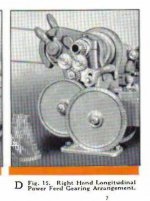Hi guys,
I'm the new owner of a 1921 South Bend 27-A, 11" lathe. Among all of the things I'm trying to figure out, to get it going, is how to get the auto-feed rate slow enough for longitudinal cutting. It has a 110T gear on the 8TPI lead screw, and a 32T on the spindle stud, giving me 27.5TPI, or 0.036"/rev, which is way too fast for auto-feed with this 1/3hp motor. 16T spindle gear, (smallest I've seen), gets me to 0.018"/rev, which is still too fast.
Is there some way to compound these, or am I missing something? The only way I see to get to the 0.004"/rev with simple gearing is with a 16T spindle and 500T lead screw gear, and I doubt that was ever a thing. I found mention of compound gearing with some of the bigger and later lathes, but never these 11".
Any suggestions?
Thank you,
SB27A

I'm the new owner of a 1921 South Bend 27-A, 11" lathe. Among all of the things I'm trying to figure out, to get it going, is how to get the auto-feed rate slow enough for longitudinal cutting. It has a 110T gear on the 8TPI lead screw, and a 32T on the spindle stud, giving me 27.5TPI, or 0.036"/rev, which is way too fast for auto-feed with this 1/3hp motor. 16T spindle gear, (smallest I've seen), gets me to 0.018"/rev, which is still too fast.
Is there some way to compound these, or am I missing something? The only way I see to get to the 0.004"/rev with simple gearing is with a 16T spindle and 500T lead screw gear, and I doubt that was ever a thing. I found mention of compound gearing with some of the bigger and later lathes, but never these 11".
Any suggestions?
Thank you,
SB27A




